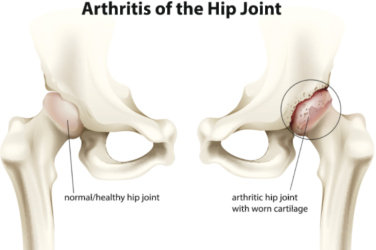
Osteoarthritis is a condition that affects the joints
Osteoarthritis is a condition that affects the joints, it's the most common form of arthritis in the UK according to the NHS and around 1 million people see there GP about it every year.
But how can you treat it?
What is Hip Osteoarthritis?
Hip osteoarthritis is a condition that occurs when the cartilage in the hip joint is worn out or injured. Cartilage is a rubber-like substance between all joints that serves as a shock absorber during movement. It consists of protein and lots of water. When compressed, cartilage changes shape, taking in the shape of the bone pressing it. That is just like laying a cushion in between bones. Sometimes the cartilage between the hip joint may become worn out due to age or injury. This means the hip bones rub against each other with little or no cushion. The friction that occurs causes a lot of pain to the patient.
Causes and Symptoms
As Hip arthritis is more of a condition rather than a disease, there is no single pathogen that can be pointed to be the cause of. However, just like any other condition, there has to be causes or factors that trigger the onset of the condition.
- Malformed joints
The hip joint may have failed to form properly at inception and with increase of body mass with age; the pressure exerted on the hip becomes unbearable for the hip cartilage to take. Hip osteoarthritis then strikes.
- Genetically Acquired Defects
The condition may be running through a bloodline. This means a person can inherit defects of the cartilage from the genes of a parent.
- Age
Advancement in age makes the cartilage in the hip joint to degenerate at a higher rate than the body is able to repair it. It happens gradually and the pain may advance from mild to severe as one ages.
- Stressing the Hip Joint
This may occur when one puts on weight and the body mass exerts excessive pressure on the hip joint cartilage and gradually destroying it. Other times one may be involved in strenuous activities like sports or carrying heavy loads which place direct pressure on the hip joint hence messing it up.
On the onset of hip osteoarthritis, a patient will experience pain in the hip and groin after waking up. This pain intensifies during the active hours of the day and seems to cease when one gets a rest. It is good to seek medical attention at this point because the cartilage will degenerate subsequently and you will reach a point where resting becomes no longer a remedy to the pain.
The Diagnosis
There is no particular medical procedure carried out to detect hip osteoarthritis. Your physician will examine the general functionality of the hip joint. An x-ray may also be taken to check the condition of the hip-joint. Joint fluid can also be checked to detect any other type of arthritis. The doctor can also perform an MRI or a CT scan.

Treatment of Hip Osteoarthritis
Hip Osteoarthritis is not fatal however the pain that comes with it can bring a lot of discomforts in life. It is advisable that if you have symptoms related to hip osteoarthritis that you seek medical attention early. Waiting for the pain to flare up so that you seek medical attention may be dangerous. The more the pain the more damage caused on the joint. Hip osteoarthritis is not reversible though some remedies will alleviate the excess pain and check the progression of the damage to the joint.
Recommendations by Osteoarthritis Research Society International on Hip Osteoarthritis treatment can be summarized as follows:
Combine both drug and non-drug treatments. Drugs will be obtained from your physician while non-drug treatment can include:
- Personal therapies – Focus on what you can do to yourself more than what professional therapists will administer to you. You are your first and trusted therapist!
- Professional Therapist – He will advise on the right exercises to do and evaluate your progress at all times. He can also advice on devices that you can use to make your daily chores lighter.
- Aquatic Exercises – Maintaining a regular aerobic and swimming program can strengthen muscles and lower the intensity of pain.
- Weight Management – In cases of overweight patients, getting to a program that will shed those extra kilos can be a great step towards lessening the pain.
- Walking Aids – These can greatly help in easing the pain because you will transfer your body weight to the aid when you walk.
- Heat/Cold Packs – Press hot or cold packs on the hip joint according to what works for you. To some cold will work while others heat does better. A cold or hot bath can also be soothing.
- Transcutaneous Electrical nerve Stimulation (TENS) – A weak electric current is passed through electrodes placed on the hip joint. This is believed to inhibit pain receptors to send pain messages to the brain. It is short lived but it helps a lot.
Surgery
This may be the last option one can take if all the rest therapeutic and drug administration have failed. This involves the replacement of the ball and socket joints of the hip. The pain goes and the functionality of the joint is improved.
Typical Myths about Hip Osteoarthritis
Hip osteoarthritis is a normal outcome of aging. This is not true. Old people do not get hip osteoarthritis by default. There are so many with healthy hips.
There is so little can be done about hip osteoarthritis. This is a baseless argument because there are so many exercise programs, therapies and medication that are known conquer the pain in mild osteoarthritis and ease that of the severe one.
Hip osteoarthritis are general pains and aches in the hip joint. This is a myth because the causative agents and the biology behind the hip osteoarthritis condition has long been established.
Prognosis
Of all kinds of osteoarthritis, hip osteoarthritis comes second in terms of numbers of affected persons. It is a serious condition and that should not be over looked. Joints become stiff, inflamed and painful and the patient can not enjoy life any more. While it remains incurable, it is certainly treatable and the therapies involved can allow one to live with less pain and improve his/her general performance.
Churchill Otieno
Churchill Otieno, holds a degree in Communications and Public Relations. He is an accomplished independent researcher, experienced, professional writer based in Chicago, IL past Nairobi, Kenya. He has been writing articles on health for more than two years with interest on bone, joint health, arthritis, osteoarthritis etc. He is truly passionate about lifestyle, beauty and fitness. He is also contributing articles for many other popular websites. His mission is to educate, empower and advocate people whose lives have changed due to certain illness. He also strive to support the families and caregivers as they learn how to advocate and care for the afflicted person.
You can also keep up-to-date with him via Twitter or Facebook.
Tagged in Arthritis

